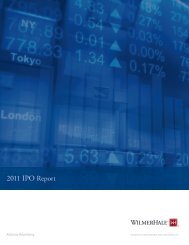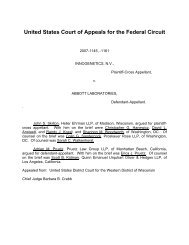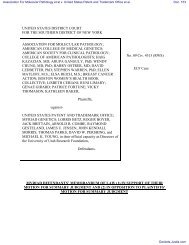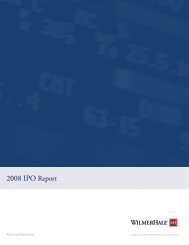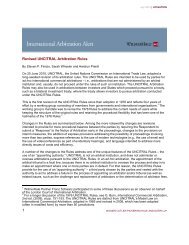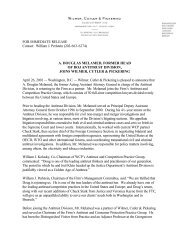2009 IPO Report - WilmerHale
2009 IPO Report - WilmerHale
2009 IPO Report - WilmerHale
- No tags were found...
You also want an ePaper? Increase the reach of your titles
YUMPU automatically turns print PDFs into web optimized ePapers that Google loves.
US <strong>IPO</strong> Market Review and Outlook5Profile of Successful <strong>IPO</strong> CandidatesWhat does it really take to go public?There is no single profile of a successful <strong>IPO</strong>company, but in general the most attractivecandidates have the following attributes:■Outstanding Management: An investmenttruism is that investors invest in people,and this is even more true for companiesgoing public. Every company goingpublic needs experienced and talentedmanagement with high integrity, avision for the future, lots of energy towithstand the rigors of the <strong>IPO</strong> process,and a proven ability to execute.■Market Differentiation: <strong>IPO</strong> candidates needa superior technology, product or servicein a large and growing market. Ideally, theyare viewed as market leaders. Appropriateintellectual property protection is expectedof technology companies, and in somesectors patents are de rigueur.■Substantial Revenues: With someexceptions, substantial revenues areexpected—at least $50 million to $75million annually—in order to providea platform for attractive levels ofprofitability and market capitalization.■Revenue Growth: Consistent and strongrevenue growth—25% or more annually—is usually needed, unless the company hasother compelling features. The companyshould be able to anticipate continuedand predictable expansion to avoidthe market punishment that accompaniesrevenue and earnings surprises.■Profitability: Strong <strong>IPO</strong> candidatesoften have track records of earningsand a demonstrated ability to enhancemargins over time.How Do You Compare? Some Facts About the <strong>IPO</strong> MarketSet forth below are selected metrics about the <strong>IPO</strong> market, based on combined datafor all US <strong>IPO</strong>s in 2007 and 2008.Median offering sizeMedian annual revenue of <strong>IPO</strong> companies$120.5 million (13% below $50 millionand 8% above $500 million)$87 million (34% below $50 million and 13%above $500 million)Percentage of <strong>IPO</strong> companies that are profitable 62% in 2007 and 71% in 2008Aftermarket performanceState of incorporation of <strong>IPO</strong> companiesPercentage of <strong>IPO</strong>s including sellingstockholders, and median percentage of offeringrepresented by those sharesPercentage of <strong>IPO</strong>s including directed shareprograms, and median percentage of offeringrepresented by those sharesPercentage of <strong>IPO</strong> companies disclosingadoption of ESPPPercentage of <strong>IPO</strong> companies using a “Big 4”accounting firmForm of outside director compensation paid by<strong>IPO</strong> companiesStock exchange on which the company’scommon stock was listedMedian number of Form S-1 amendments(excluding exhibits-only amendments) filedbefore effectivenessMedian <strong>IPO</strong> expensesBy year-end, average <strong>IPO</strong> price increased15% in 2007 and decreased 36% in 2008Delaware—93%No other state over 1%Percentage of <strong>IPO</strong>s—51%Median percentage of offering—26%Percentage of <strong>IPO</strong>s—47%Median percentage of offering—5%28%77%Cash only—10%Equity only—3%Cash and equity—87%Nasdaq—65%NYSE—32%Amex—3%FiveMedian underwriting discount 7%Time elapsed from initial filing to effectivenessof the Form S-1Legal—$1,200,000Accounting—$810,000Total—$2,760,000Median—117 calendar days25th percentile—89 calendar days75th percentile—170 calendar days■Market Capitalization: The company’spotential market capitalization shouldbe at least $200 million to $250 million,in order to facilitate development of aliquid trading market. If a large portionof the company will be owned by insidersfollowing the <strong>IPO</strong>, a larger market cap maybe needed to provide ample float.All <strong>IPO</strong> companies need top executive talent,a strong competitive position, adequate marketcapitalization and deal-savvy advisors, butother factors can vary based on a company’sindustry and size. For example, many biotechcompanies will have much smaller revenuesand not be profitable. More mature companiesare likely to have greater revenues and marketcaps, but slower growth rates. High-growthcompanies are likely to be smaller, and usuallyhave a shorter history of profitability.Beyond these objective measures, <strong>IPO</strong>candidates need to be ready for publicownership in a range of other areas, includingemployee recruitment and retention; accountingpreparation; corporate governance; financialand disclosure controls and procedures;external communications; and a varietyof corporate housekeeping tasks.



